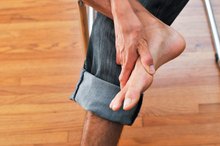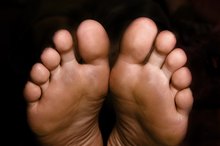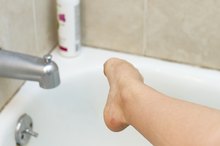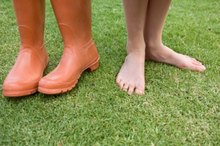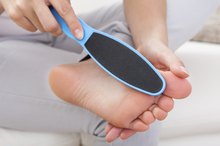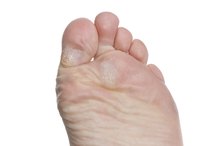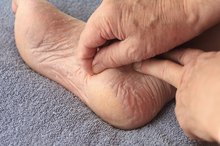Do Podiatrists Remove Corns?
A corn is a spot on the foot made of skin that has thickened as a response to pressure. Though the skin buildup is the body's way of protecting itself, when it goes on too long, the resulting corn can be painful. When the problem is serious enough to warrant medical attention, a podiatrist is the right professional to see about getting the corn removed. Corns are, in fact, one of the most common problems that such specialists treat.
Features
Corns take a cone or horn shape, directed downward into the skin. The tend to appear between the toes, in which case they are soft because of the moisture present in that area, or on the outer surface of the little toe, in which case they are hard. They cause discomforting ranging from mild to severe, even to the point that walking is difficult. They can become infected, taking on a red, inflamed appearance and causing even more pain. A podiatrist is best equipped to diagnose whether your problem is indeed a corn.
- Corns take a cone or horn shape, directed downward into the skin.
- The tend to appear between the toes, in which case they are soft because of the moisture present in that area, or on the outer surface of the little toe, in which case they are hard.
Causes
How Does Corn Removal Work?
Learn More
Corns develop due to pressure. The pressure may arise from shoes that are ill-fitting, from foot deformities such as hammer toes or from abnormalities of gait that put pressure on certain areas of the foot. If necessary, a podiatrist can refer you to an orthotist—a professional who works on splints and braces—who can adapt a shoe to decrease pressure.
Prevention/Solution
The best way to avoid corns: Wear shoes that fit correctly. In particular, they should not be too tight. Once corns have developed, a podiatrist can cut them out. But they'll come back unless the source of the pressure is addressed. Using special pads and supports within the shoes, having bony prominences removed surgically and exercising proper foot hygiene can help to prevent further problems.
- The best way to avoid corns: Wear shoes that fit correctly.
Warning
How to Remove Corns Permanently
Learn More
Various paints and plasters are available as home remedies for corns. They eat the corn away. The problem is, they can also eat normal skin. This can result in ulcers and infections. People with bad circulation or with diabetes could end up facing amputation. Cutting the corns off yourself can also be dangerous, because this method also carries a high risk of infection. Additionally, home removal without proper follow-up care with a podiatrist yields a high likelihood that the corns will return, because the underlying issue are not be addressed.
- Various paints and plasters are available as home remedies for corns.
- Cutting the corns off yourself can also be dangerous, because this method also carries a high risk of infection.
Considerations
Be sure to choose a reputable, licensed podiatrist when seeking care for corns. After completing a bachelor's degree, podiatrists must finish four years of podiatric college. The tend to be in solo practice, though group practice is not uncommon. To find a good podiatrist, go with a referral from a friend or family member, or check with the American Podiatric Medical Association 2.
- Be sure to choose a reputable, licensed podiatrist when seeking care for corns.
- To find a good podiatrist, go with a referral from a friend or family member, or check with the American Podiatric Medical Association 2.
Related Articles
References
- Epodiatry.com: Foot Corns & Callus (hyperkeratosis)
- American Podiatric Medical Association: About Podiatry
- DeLauro T and DeLauro M (2012) Chapter 98: Corns and Calluses. Fitzpatrick's Dermatology in General Medicine (8th Edition). New York, New York: McGraw-Hill Education. ISBN-13: 978-0071669047.
- American Academy of Dermatology Association. How to treat corns and calluses. 2019.
- Reddy P, Anusha T, Haritha N, Nagendra A, Bhavani D, Gandhimathi R. Case report on non-surgical treatment for foot corn. International Journal of Dermatopathology and Surgery. 2018;4(1).
- American Academy of Dermatology Association. How to Treat Corns and Calluses. 2019.
- DeLauro T and DeLauro M (2012) Chapter 98: Corns and Calluses. Fitzpatrick's Dermatology in General Medicine (8th Edition). New York, New York: McGraw-Hill Education. ISBN-13: 978-0071669047.
Writer Bio
Ranlyn Oakes is a business writer and journalist with more than a decade as either a staff writer or freelancer for a variety of regional and national publications, including newspapers and magazines. His specialties include health care, international trade, manufacturing and career advice. Oakes holds a Bachelor of Arts in print journalism from the University of Kentucky.

